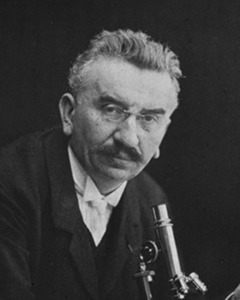| Louis Lumière  AKA Louis Jean Lumière AKA Louis Jean Lumière
Born: 5-Oct-1864
Birthplace: Besancon, France
Died: 6-Jun-1948
Location of death: Bandol, France
Cause of death: unspecified
Remains: Buried, Cimètiere de la Guillotière, Lyon, France
Gender: Male
Race or Ethnicity: White
Sexual orientation: Straight
Occupation: Inventor Nationality: France
Executive summary: Inventor of motion pictures His father, Antoine Lumière (1840-1911), was a painter of portraits who had a studio in Besançon, and added the relatively new technique called photography to his services in 1861. At this shop in 1882 Louis Lumière and his brother Auguste developed a new apparatus for the mechanized production of photographic gelatin dry-plates, which had been introduced several years earlier, eliminating the need for plates to be stored in a darkroom before and after exposure. The Lumières' method of mass-producing these dry-plates made the hobby and profession of picture-taking far more convenient, and transformed the brothers' business from a struggling shop into a minor industrial concern. By 1900 Lumière & Sons was one of Europe's largest photographic firms.
In 1894, their father returned from a trip to America excited about a new technology he had seen demonstrated, Thomas Edison's kinetoscope, and the elder Lumière's impassioned description of the device inspired his sons' imagination. Kinetoscopes, however, could only be viewed by one person at a time, by peering through a peephole into a mechanized box. Louis Lumière envisioned something different -- a projected image that could be shared by an audience, in the same way that audiences share a play. With his brother's assistance, Lumière designed the Cinematograph, a self-contained camera and projector which used a clawed-gear to advance sprocketed film, a principle used in movie cameras and projectors for more than a century since. The machine was constructed by their colleague, engineer Charles Moisson, and was lightweight enough to be effectively portable, allowing the capture of motion at almost any location.
The Cinematograph was patented in both brothers' names on 13 February 1895, though Auguste Lumière generally conceded that his brother was its primary inventor. It was the first apparatus for making and showing films to audiences in a way that would be recognizable today as "going to the movies", and the Lumière brothers are often credited as inventors of the motion picture. They presented the first public screening of a movie, La Sortie des Usines Lumière (Workers Leaving the Lumière Factory), at the Société d'Encouragement de l'Industrie Nationale in Paris on 22 March 1895. Nine months later, on 28 December 1895, they held the first motion picture exhibition for a paying audience, presenting a twenty-minute program of ten of their short films (though the adjective "short" was not yet applicable) in a rented room at the Grand Cafe on Boulevard des Capucines in Paris. According to legend, when a clip of a train advancing toward the camera and crowd was projected on the screen, men screamed, women fainted, and much of the audience ran toward the back of the auditorium.
The Lumières, however, saw motion pictures more as a curiosity than a business venture, and they withdrew from motion picture production in about 1901, as other technology soon superseded the Cinematograph. They continued in the photography business with great success, however, introducing the popular Autochrome system of color photography in 1904, and the Lumière brand remained a stalwart of European photography for decades. After Auguste Lumière stepped away from the business in 1910, Louis Lumière introduced a stereoscopic photography system in 1920, and a three-dimensional motion picture system in 1930. In a fitting coincidence, their surname, Lumière, translates to English as the word "light". Father: Claude Antoine Lumière (artist/photographer, b. 13-Mar-1840, d. 15-Apr-1911)
Mother: Jeanne Joséphine Costille Lumière (b. 29-Jul-1841, m. 1861, d. 20-Dec-1915)
Brother: Auguste Marie Nicolas Lumière b. 19-Oct-1862 Besancon, France, d. 10-Apr-1954 Lyon, France
Sister: Jeanne Claudine Odette Lumière Koehler (b. 2-Apr-1870, d. 24-Oct-1926)
Sister: Juliette Lumière Winckler Gélibert (b. 30-Sep-1873, d. 25-Jan-1924)
Sister: Francine Lumière Winckler ("France", b. 18-Sep-1882, d. 3-May-1924)
Brother: Edouard Lumière (b. 18-Nov-1884, d. 17-Apr-1917 World War I)
Wife: Jeanne Rose Léonie Winckler Lumière (b. 3-Oct-1868, m. 2-Feb-1893, d. 21-Oct-1925, three children)
Daughter: Marguerite Jeanne Suzanne Lumière Trarieux (b. 15-Sep-1894, d. 24-Dec-1973)
Son: Jean Lumière (b. 1898, d. 1898 stillborn)
Daughter: Albertine Louise Yvonne Lumière (b. 28-Apr-1907, d. 4-Apr-1993)
High School: La Martinière Technical High School, Lyon, France (1880)
French Academy of Sciences 1919
French Legion of Honor
Hollywood Walk of Fame 1529 Vine Street (motion pictures)
Royal Photographic Society
French Ancestry
Asteroid Namesake 775 Lumière (named for both brothers)
Author of books:
Résumé des Travaux Scientifiques de MM. Auguste et Louis Lumière (1914, memoir)
Correspondances of Auguste and Louis Lumière 1890-1953 (1994, letters; posthumous)
Requires Flash 7+ and Javascript.
Do you know something we don't?
Submit a correction or make a comment about this profile
Copyright ©2019 Soylent Communications
|